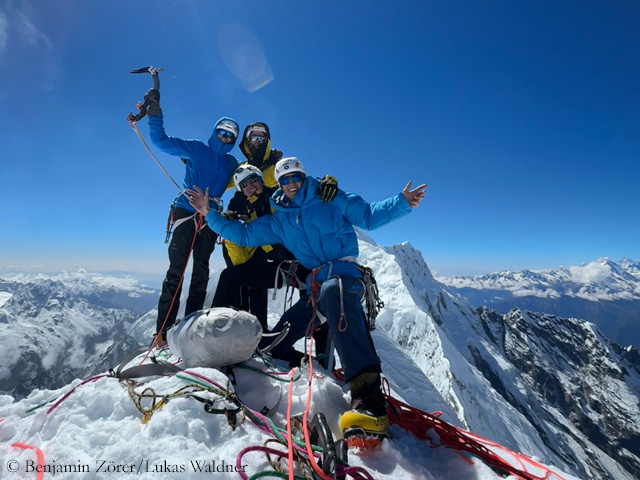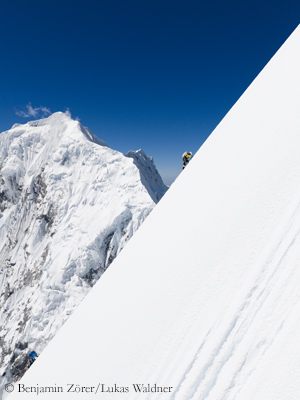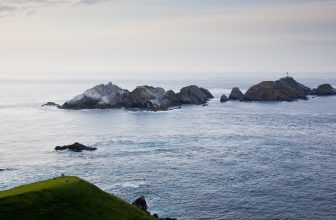

It was one of the many exciting alpinistic highlights of this fall season in the Himalayas. The two Austrians Lukas Waldner (24) and Benjamin Zörer (24) and the Italians Francois Cazzanelli (35) and Giuseppe Vidoni (31) succeeded in making the first ascent of Kimshung in Nepal in alpine style.
The 6,781-meter-high mountain, also known as Tsangbu Ri, is located in Langtang National Park, about 75 kilometers north of the capital Kathmandu as the crow flies.
On 20 October, the four mountaineers climbed from their advanced camp at 5,450 meters on the Kimshung Glacier to the summit in just ten hours and descended again on the same day. They named their route (1,300 meters, 60°, AI4, M5) “Destiny”: “for the many stories that converged beneath this mountain – including the meeting of the four climbers who return home not only with a proud ascent, but above all, with a great new friendship,” as the quartet wrote on Instagram.

Two rope teams joined forces
The mountaineers from Austria and Italy had only met at the foot of the mountain and decided to climb together. Cazzanelli had already attempted Kimshung twice without success. In 2015, his team had been stopped by the devastating earthquake in Nepal, which killed almost 9,000 people. In 2016, Francois had to abandon his attempt on Kimshung after being hit by a rock at an altitude of almost 6,000 meters.
After returning from Nepal, Tyrolean mountaineer Lukas Waldner answered my questions about the now successful expedition.
Lukas, how do you rank the first ascent of Kimshung in your personal career?
The first ascent of Kimshung was clearly one of the greatest successes of our career so far. Especially when we look back on our expeditions, this summit is one of the really big moments.
A high, technical six-thousander, long unclimbed – something like that was always more of a dream in the back of my mind. The fact that it actually happened and we stood on the summit on 20 October feels like a real milestone.
How did you and Benjamin end up teaming up with the Italians Francois and Guiseppe?
Benjamin and I had already heard in the summer before the expedition that an Italian group would also be en route on Kimshung. In this elite circle of mountaineering, the scene is extremely small – you find out relatively quickly who is where and when.
Once we were in Langtang, we talked to the Italians repeatedly, exchanged information, and loosely coordinated our plans. When a good weather window finally appeared, it quickly became clear to us that we all wanted to give it a try.

In the end, we set off in two rope teams – not directly together, but very consciously as a joint project: two teams who knew that the other rope team was also on the wall, kept an eye on each other, and saw the whole thing more as cooperation than competition.
How important was Francois, who had already been involved with the mountain for ten years, to your success?
For Francois, Kimshung was an extremely emotional mountain – with many beautiful but also difficult experiences over the last ten years. You could feel this long history in every decision he made.
For us, it was of course an advantage to have someone on the team who already knew the mountain. Even though he had only made one serious attempt on this particular side and the conditions change significantly every year, such background knowledge brings small advantages at some points.

Nevertheless, it wasn’t as if we simply followed a “ready-made plan.” It was more of a mixture: his experience, our fresh perspective, and the current circumstances – and that’s how our common approach emerged.
What formative experience did you take home with you from Kimshung?
For me, one of the most formative experiences was that big goals are really achievable if you stick with them long enough – as a person, but also as a community. For years, Kimshung was something of a symbol of how persistent you sometimes have to be.

This climb also showed me that alpinism at this level doesn’t have to be a competition. Especially with the Italians, it was much more of a collaborative effort: you climb in different rope teams, but somehow you still climb “together” – you support each other, share information, share responsibility, and ultimately share the success. I take this feeling that cooperation is stronger than competition home with me from Kimshung.







